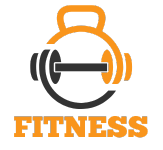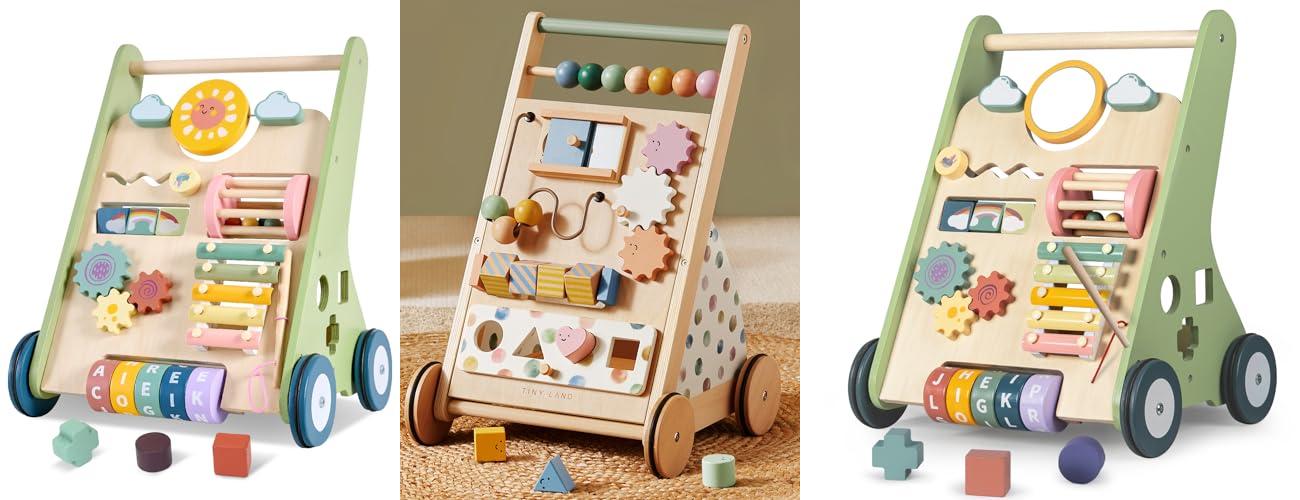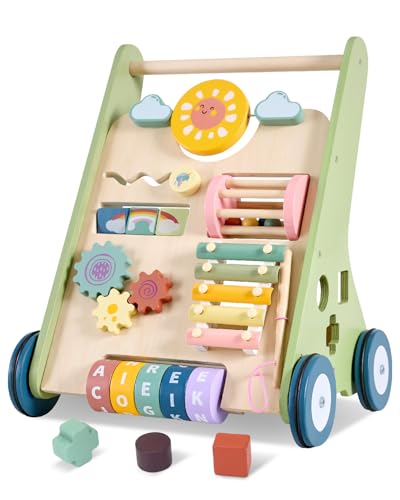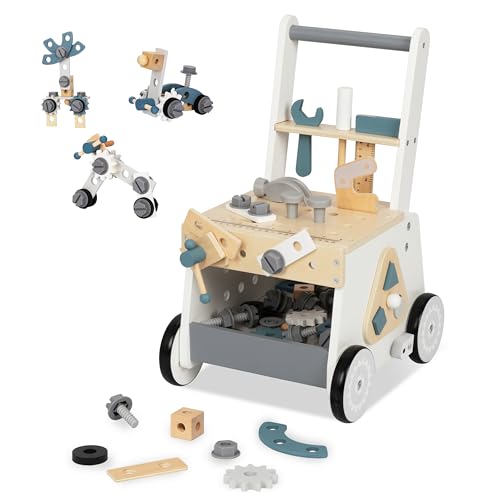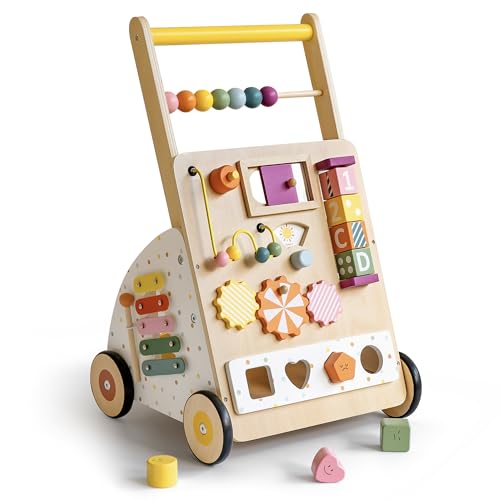Imagine your little one taking their very first wobbly steps, a monumental milestone filled with excitement and a touch of parental anxiety. As they gain confidence and begin to explore their world, a good push walker can be a wonderful companion. But with so many choices out there, how do you pick the perfect one that aligns with Montessori principles and truly supports your child’s development?
Choosing a Montessori push walker can feel overwhelming. You want something safe, sturdy, and that encourages independence, not just a toy that lets them zoom around. It’s easy to get lost in a sea of plastic and flashing lights, wondering which option will actually foster natural learning and movement. You might be worried about something tipping over or not providing enough support for those early explorations.
This post is here to help! We’ll dive deep into what makes a Montessori push walker truly beneficial, cutting through the confusion. You’ll learn what to look for, understand the key features that support your child’s natural drive to move and explore, and discover how to make a choice you feel great about. Get ready to find the perfect tool to empower your child’s walking journey.
Our Top 5 Montessori Push Walker Recommendations at a Glance
Top 5 Montessori Push Walker Detailed Reviews
1. Baby Push Walker
Rating: 9.4/10
Discover the ultimate learning companion for your little one with our Wooden Baby Walker and Activity Toy. This Montessori-inspired walker is designed to grow with your baby, offering endless fun and developmental benefits.
What We Like:
- Engaging Activities: Features a rotating mirror, xylophone, maze, gears, letter ring, and shape sorters for hours of interactive play that boost cognitive skills and hand-eye coordination.
- Promotes Healthy Development: Encourages correct walking posture, preventing bow-legs and building confidence for those crucial first steps.
- Adjustable for Safety: Wheel screws can be loosened or tightened to control speed, creating a safe environment as your baby learns to walk.
- Practical Storage: A spacious storage compartment in the back lets your child carry their favorite toys or snacks.
- Premium and Safe Materials: Crafted from FSC certified, 100% natural solid wood with smooth, burr-free surfaces and rubber-coated wheels to protect floors. It meets strict ASTM, CPC, and CPSIA safety standards.
- Perfect Gift Idea: An ideal present for birthdays, holidays, or any occasion for toddlers aged 12 months and up.
What Could Be Improved:
- Assembly may require a screwdriver and instructions, which could be a minor hurdle for some.
This wooden baby walker is more than just a toy; it’s an investment in your child’s development and a delightful addition to their playtime. Give the gift of exploration and confident steps with this beautifully crafted activity walker.
2. Tiny Land Wooden Baby Walker
Rating: 8.8/10
The Tiny Land Wooden Baby Walker is a fantastic tool for little ones learning to walk. It’s more than just a way to get around; it’s a fun learning station packed with activities. This walker helps babies develop important skills while they explore and gain confidence.
What We Like:
- It’s a multifunctional play walker that keeps babies busy with a mirror, gears, and other learning toys.
- The rear rack is perfect for carrying favorite toys, making every walk an adventure.
- The adjustable speed control helps parents set the right pace for their child’s walking journey, ensuring safety and building confidence.
- It’s built with safe, natural wood and non-toxic finishes, so parents can trust its quality.
- The silent rubber wheels are gentle on floors, and smooth edges protect little hands.
- The stylish Morandi colors and charming designs look great in any home and appeal to both boys and girls.
- It’s inspired by Montessori principles, encouraging independent exploration and supporting a child’s development in motor skills, coordination, and sensory growth.
What Could Be Improved:
- While the adjustable speed is a great feature, some parents might prefer a wider range of speed settings for very early walkers.
- The mirror is a fun addition, but a slightly larger or more reflective surface could enhance sensory engagement.
This Tiny Land Wooden Baby Walker offers a wonderful blend of fun and education. It’s a durable, safe, and stylish choice that supports your child’s development every step of the way.
3. Bautia Wooden Baby Walker
Rating: 8.8/10
The Bautia Wooden Baby Walker is more than just a push toy; it’s a complete developmental hub designed to engage and support your little one’s journey from crawling to confident steps.
What We Like:
- This walker offers a fantastic MULTIPLE ACTIVITY CENTER. It includes a lively interactive panel, a rolling letter wheel, a xylophone, a flip board, and a tracking game. These features help develop hand-eye coordination and cognitive skills.
- It’s a NATURAL CHOICE, made from high-quality wood with smooth edges for safety. The sturdy design ensures it’s a healthy and safe option for babies.
- The rubber wheels are silent and won’t scratch your floors.
- This walker is PERFECT FOR FIRST STEPS. Its stable construction provides excellent support as babies learn to stand and walk, helping them improve balance and gait.
- The walker has great DEVELOPMENTAL BENEFITS. It sparks imagination and encourages active play and exploration with its engaging features.
- It makes an ideal FIRST BIRTHDAY GIFT. It’s a charming and timeless present that supports early learning and discovery.
- The company offers great customer service, promising to help with any missing accessories or issues.
What Could Be Improved:
- While designed for 6-12 months, some babies might outgrow the walker’s primary pushing function before they fully master walking, though the activity panel remains engaging.
- The comprehensive nature of the activity panel might make the walker slightly heavier than a very basic push toy, which could be a consideration for some parents.
This Bautia Wooden Baby Walker is a wonderful investment for your child’s early development. It offers a safe, engaging, and fun way for them to learn and grow.
4. Wooden Baby Push Walker for Toddlers – Multifunctional Montessori Tool Bench Baby Walking Toy with Educational Activities
Rating: 9.3/10
This Wooden Baby Push Walker is a fantastic 2-in-1 toy designed to help your little one take their first steps while sparking their imagination. It’s more than just a walker; it’s a complete activity center that grows with your child.
What We Like:
- The interactive tool bench features realistic hammers, wrenches, and gears that encourage imaginative role-play and boost creativity.
- It offers an enhanced educational experience, promoting problem-solving and fine motor skills through hands-on building.
- Safety is a top priority with an upgraded speed retarder for controlled movement, giving parents peace of mind.
- The smart storage solution keeps all the tools and accessories neatly organized, preventing clutter.
- It’s a perfect gift that combines fun and learning, ideal for birthdays or holidays for boys and girls aged 3 years.
What Could Be Improved:
- While it’s designed for 3-year-olds, some younger toddlers might need a bit more time to develop the coordination to fully utilize all the tool bench features.
- The wooden construction, while durable, might be heavier than some plastic alternatives, which could be a minor consideration for extremely small or less mobile children.
This walker is a wonderful investment for any toddler’s development. It provides hours of engaging play while supporting crucial early learning milestones.
5. Wooden Baby Walker with Activity Center – Montessori Push Walker Toys for Boys & Girls 18 Months+ – Educational Toddler Learning Walker with 10-in-1 Sensory Games
Rating: 9.1/10
This Wooden Baby Walker with Activity Center is a fantastic toy designed to entertain and educate toddlers. It’s more than just a walker; it’s a hub of discovery for little ones aged 18 months and up. It helps them take their first steps while keeping them engaged with a variety of fun activities.
What We Like:
- The 10-in-1 activity center provides endless entertainment with a bead maze, mirror, shape sorter, and more.
- It’s designed to boost early learning, helping with fine motor skills, hand-eye coordination, and color recognition.
- The walker is made from safe, natural wood with smooth edges and non-toxic paints, ensuring it’s safe for your child.
- Rubber wheels protect your floors and allow for quiet movement.
- Its Montessori-inspired design encourages independent play and parent-child bonding.
- It makes a wonderful first birthday gift, combining fun and learning.
What Could Be Improved:
- While the variety of activities is great, some very young toddlers might need a little help navigating all the different games at first.
- The scratch music panel, while fun, might not produce the most melodious sounds for adult ears!
This wooden walker is a well-rounded toy that offers significant developmental benefits. It’s a smart investment for any parent looking for a toy that’s both fun and educational.
Choosing the Best Montessori Push Walker: A Parent’s Guide
A Montessori push walker is a fantastic tool for babies who are just starting to find their feet. It helps them build confidence and coordination as they explore their world on the move. This guide will help you pick the perfect walker for your little one.
Why Choose a Montessori Push Walker?
Montessori principles focus on independence and self-directed learning. A push walker aligns with this by allowing your baby to move at their own pace. It encourages gross motor skills and problem-solving. Unlike traditional walkers that confine babies, a push walker lets them explore freely and safely.
1. Key Features to Look For
When you’re shopping for a Montessori push walker, keep these important features in mind:
- Sturdy Construction: The walker needs to be strong and stable. It should not tip over easily when your baby leans on it. Look for a wide base that offers good balance.
- Weight and Balance: A walker that’s too light might tip. A walker that’s too heavy might be hard for your baby to push. The ideal weight helps it stay grounded but still allows for easy movement.
- Handlebar Height: The handlebar should be at a comfortable height for your baby. They should be able to stand up straight and hold it without stooping too much.
- Non-Slip Wheels: Smooth wheels are good, but wheels with some grip are better. This prevents the walker from sliding too fast on slick floors. Some walkers have adjustable speed settings for the wheels.
- Engaging Activities: Many Montessori push walkers come with built-in activities. These can include beads to slide, gears to turn, or shape sorters. These add extra learning and fun.
- Safety Features: Check for rounded edges and no small, detachable parts that could be a choking hazard.
2. Important Materials
The materials used in a push walker play a big role in its safety and durability.
- Wood: Natural wood is a popular choice for Montessori toys. It’s durable, safe, and has a lovely feel. Look for solid wood like beech or maple. These woods are strong and last a long time.
- Non-Toxic Finishes: If the wood is painted or sealed, make sure the finishes are non-toxic. This is important for your baby’s health, as they might put their hands or the walker in their mouth.
- Durable Plastics (Used Sparingly): Some walkers might use BPA-free plastics for certain parts, like wheels or activity pieces. Ensure these are high-quality and safe.
3. Factors That Improve or Reduce Quality
Certain aspects can tell you if a walker is well-made or not.
- Improved Quality:
- Smooth Finish: A well-sanded and smooth finish on wooden parts shows attention to detail.
- Solid Joinery: How the parts are put together matters. Strong joints mean the walker won’t fall apart.
- Reputable Brands: Brands known for making quality wooden toys often have better products.
- Reduced Quality:
- Wobbly Parts: If any part of the walker feels loose or wobbly, it’s a sign of poor construction.
- Rough Edges: Sharp or rough edges on wood can be a safety concern.
- Cheap Plastic: Flimsy plastic parts can break easily.
4. User Experience and Use Cases
How a push walker is used and how easy it is to manage are key.
- Ease of Assembly: Most walkers are fairly easy to put together. Some might require a screwdriver. Check reviews to see if assembly is straightforward.
- Portability: While most walkers are meant for home use, some are lighter and easier to move from room to room.
- Learning Through Play: The built-in activities provide great opportunities for learning. Babies can develop fine motor skills by manipulating beads or gears. They also learn cause and effect.
- Encouraging Independence: The walker empowers your baby to explore their environment. They can move around the house with confidence. This is a core Montessori idea.
- Aids in Walking Development: It provides support as your baby transitions from crawling to walking. It helps them build leg strength and balance.
Frequently Asked Questions (FAQ)
Q: What is a Montessori push walker?
A: A Montessori push walker is a toy designed to help babies who are learning to walk. It gives them something stable to hold onto as they move forward.
Q: What age is a Montessori push walker suitable for?
A: They are typically for babies who are already crawling and show signs of wanting to stand and walk. This is usually around 9-12 months old, but every baby develops differently.
Q: Is a Montessori push walker safe?
A: Yes, when chosen carefully. Look for sturdy construction, non-toxic materials, and a stable design. Always supervise your baby while they use it.
Q: What are the benefits of a Montessori push walker?
A: Benefits include improved gross motor skills, better balance, increased confidence, and the development of independence. Many also offer fine motor skill activities.
Q: Should I get a wooden or plastic push walker?
A: Wooden push walkers are often preferred in the Montessori philosophy for their durability and natural feel. However, high-quality, BPA-free plastic walkers can also be a good option.
Q: How do I know if the handlebar height is right?
A: Your baby should be able to stand up straight and hold the handlebar comfortably without having to bend over too much.
Q: Can a push walker help my baby walk faster?
A: It helps them develop the skills and confidence needed to walk. It doesn’t force them to walk faster but supports their natural development.
Q: Are there any activities I should look for on a push walker?
A: Yes, activities like bead mazes, shape sorters, or spinning gears enhance learning and keep your baby engaged.
Q: How do I clean a Montessori push walker?
A: For wooden walkers, a damp cloth is usually enough. Avoid soaking the wood. For plastic parts, use mild soap and water.
Q: Can my baby use a push walker for a long time?
A: Many babies use them for several months as they gain confidence. Once they are walking steadily, they may lose interest in the walker.
In conclusion, every product has unique features and benefits. We hope this review helps you decide if it meets your needs. An informed choice ensures the best experience.
If you have any questions or feedback, please share them in the comments. Your input helps everyone. Thank you for reading.
